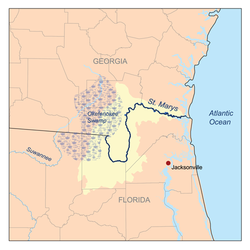| Battle of Fort Peter | |||||||
|---|---|---|---|---|---|---|---|
| Part of War of 1812 | |||||||
 St. Marys River | |||||||
| |||||||
| Belligerents | |||||||
|
|
| ||||||
| Commanders and leaders | |||||||
|
Land: unknown Sea: George Cockburn |
Abraham A. Massias Daniel Newnan | ||||||
| Strength | |||||||
|
Land: 1,500 unknown artillery Sea: 1 Third Rate 1 Fourth Rate 4 Fifth Rates 2 bomb ketchs 2 schooners[1][note 1] |
Land: 160 8 guns Sea: 2 gunboats | ||||||
| Casualties and losses | |||||||
|
3 killed 5 wounded |
1 killed 4 wounded 9 missing 8 guns captured 2 gunboats captured 12 merchantmen captured | ||||||
The Battle of Fort Point Peter was a successful attack in early 1815 by a British force on a smaller American force on the Georgia side of the St. Marys River near St. Marys, Georgia. The river was then part of the international border between the United States and British-allied Spanish Florida; it now forms part of the boundary between Georgia and Florida. Occupying coastal Camden County allowed the British to blockade American transportation on the Intracoastal Waterway.[2] The attack on Forts St. Tammany and Peter occurred in January 1815, after the signing of the Treaty of Ghent, which would end the War of 1812, but before the treaty's ratification. The attack occurred at the same time as the siege of Fort St. Philip in Louisiana and was part of the British occupation of St. Marys and Cumberland Island.
Cite error: There are <ref group=note> tags on this page, but the references will not show without a {{reflist|group=note}} template (see the help page).